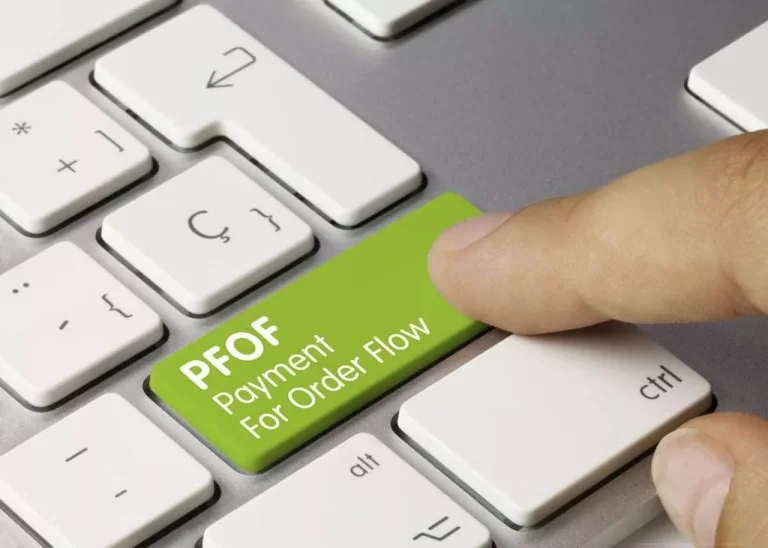In the trading sphere, novel trends have emerged and developed in the last decades, including using electronic communication networks and performing operations with zero commission. As far as its features are concerned, the title explains everything – you can make transactions without additional fees. However, intermediaries need to get monetary compensation for the services they offer. So, where does the income come from if they don’t charge a commission? Some agents receive a percentage of customers’ equity in their accounts, while other brokers suggest additional and premium products. However, if we speak about most large agents, one of the primary income channels is payment for order flow (PFOF).
In this blog post, we will discuss PFOF meaning and what profits and downsides it provides.
What Is Payment for Order Flow?
Payment for order flow was first introduced in the 1980s by the notorious investor Bernie Madoff. He was the first to introduce such a mechanism to generate commercial profits to deal with large market makers (MMs). At one point, the Madoff organization paid to obtain up to 10% of total sales on the New York Stock Exchange, which is simply a colossal sum.
PFOF is an income generation algorithm in the intermediaries area. When you operate in the share sector, there are a few categories of leading members: brokers and MMs. The first ones arrange trades for individual members, and MMs are organizations that purchase and sell assets to ensure liquidity in the area. Being an investor, let’s say you decided to place an order with assets through an intermediary; the agent does not send your deal directly to the share exchange but to the MM. The latter will execute the operation on your behalf.
Most intermediaries choose MM, which suggests the optimal value to customers. But in the PFOF mechanism, MM pays a certain percentage to provide processing transactions; this will be payment for order flow.
Such a mechanism is prevalent when trading PFOF stocks and derivatives in the US. However, it is banned in many other regions, including the UK, Canada, and Australia. At the beginning of 2023, the EU presented the project to phase out PFOF in those member countries where the practice is still common.



Turnkey Brokerage Solution For Your Business
Get the most profitable fully licensed fx/crypto brokerage software or ready-to-operate business in 48 hours. Best-in-class web & mobile trading platforms, sales-driven CRM, full integration with MT4/5, and 150+ payment providers.
How Does Payment for Order Flow Work?
If a market member seeks the value of securities from his agent, he sees a bid and ask prices. The bid cost is the value at which the user is willing to purchase the asset, while the ask price suits the asset owner. Such parameters may be obtained from the National Best Bids and Offers Survey (NBBO), which collects purchase and sell orders from crucial marketplaces.
Let’s assume the customer decides to purchase ABC shares. He contacts his agent and finds out that, according to NBBO, the bid cost is $199.96, and the ask price is $200.06. The user wants to place an order to purchase assets at $200.03, hoping the price will rise relative to the actual ask value.
The agent does not transmit such a deal to the marketplace but forwards it to MM. He is ready to execute it at $200.02. The intermediary takes the securities, sends them to the account, and happily informs the customer he could negotiate an even more favorable cost than expected. It is also a more profitable solution than what the exchange can suggest.
MM agreed to the sale at $200.02 because he received the assets at $200. This option is also more profitable than the values indicated by NBBO. MM sells at this price because he knows he can purchase securities cheaper when new orders arise on the exchange or from large investors.
The market maker receives an income of $0.2 per share. He still makes a handsome profit even if he hands the agent over half a cent per share because he forwards the deal to him.
Simultaneously, the intermediary gets a reward because he is paid for completing the deal and not the exchange. Customers also may be satisfied because they obtain the ideal offer.
Criticism of Payment for Order Flow
Many traders eventually realized their sell order included a charge, translating into a lower market price when the security was executed. Intermediaries often made deals based on what would give them the most money rather than on what would create the optimal solution to satisfy their customers.
Although many experts believe PFOF creates a conflict of interest, it has maintained its position. Only in 2021, when the GameStop (GME) meme share story happened, market members began to speak more categorically about PFOF and the integrity of intermediary organizations.
Recall in early 2021, there was a short squeeze of GME, such that leading members were shorting GME to the point that the assets sold reached 140% of the total shares outstanding. But in a place where prices were expected to fall, some portals, including Reddit’s WallStreetBets, aware of the significant short interest, raised the value of GME by almost 20 times in a couple of weeks.
According to media reports, the short squeeze was non-ordinary because it was linked to social media activity and facilitated by gamification on brokerage platforms like Robinhood, which supports individual investors. However, when the price peaked, Robinhood and other intermediaries stopped customers buying volatile GME.
Almost immediately, lawsuits against Robinhood began to be filed in courts at various levels. In total, there were more than 50 class action lawsuits related to the GME commercial halt, 15 lawsuits due to network instability, and up to 10 more cases thanks to the adoption of PFOF.
After the Gamestop story, U.S. Securities and Exchange Commission (SEC) Chairman Gary Gensler stated that PFOF could cause severe problems due to a conflict of interest.
Since some MMs suggest attractive monetary rewards to intermediary organizations more than other entities, there are cases where PFOF brokers select their capital flow rather than the user’s prosperity. Although the fiduciary norm does not uphold such organizations, they are bound by the best interest rule, which states the operation must occur on the most worthwhile terms according to the customer. Such critique is why some reputable agents refuse to adopt such an algorithm.
Potential Benefits of PFOF
An ordinary brokerage firm that may have difficulty processing a considerable sum of deals may significantly simplify its activities by sending some of them to MM. Agents who receive PFOF rewards may be forced by competition to offer better terms to customers in the form of minimum prices and commissions. However, these conditions may worsen if PFOF imposes additional customer spending due to poor quality performance.
The profit of $0.2 described in the example above sounds relatively modest, but imagine the same procedure can occur several million or billion times daily. Suddenly, this small amount turns into millions of dollars, which are successfully distributed between the organizations that pay the reward for ensuring the order flow and the participating intermediary organizations that pass on the deals.
Over the past few years, SEC filings have indicated PFOF creates significant gains in the commercial area. The maximum liquidity and ability to perform PFOF transaction without a charge are other essential benefits PFOF offers.

SEC Requirements and PFOF Regulation
While intermediaries are committed to finding the ideal deal according to a customer, the SEC warns that adopting PFOF mechanisms increases concerns about whether intermediaries are meeting their obligations to put customers’ interests above their own. Such risks worsen the reputation of the share and bond area in the eyes of future area players.
Currently, the Financial Industry Regulatory Authority (FINRA) norm 5310 requires intermediaries to exercise reasonable care to identify the optimal market and fulfill an order at the optimal price under actual market conjuncture.
In addition, the SEC believes intermediaries should communicate their policies regarding PFOF-related activities. They are required to publish statements about their commercial collaboration with MM by the 2005 directives.
Suppose you are an investor in the sector. In that case, your intermediary organization must notify you when you create the account and every year how much it receives after transmitting your deals to other financial entities. Additionally, customers of brokerage organizations may require intermediaries to provide payment information about the operation they are interested in, but the response may take a long time.
Following SEC PFOF standards 605 and 606, intermediary organizations must provide counterparties with several statements that disclose insights about the quality of fulfillment and payment parameters of order flow. The authorized institution approved these documents in 2005, but adjustments were regularly made.
In the first months of 2020, it was decided to improve the 606 standard. Now, intermediaries must publish the net payments obtained from MM when performing operations with securities of 500 of the most significant enterprises listed on stock exchanges in the USA.
In 2022, the SEC suggested adjustments to the disclosure directives by Standard 605 about executing orders in the national market system stocks due to regular changes in instruments and market trends. The updated concept extends the norms of Standard 605 directly to key intermediaries to increase clarity, raise competition, speed up order fulfillment, and provide attractive values.
How PFOF Impacts Investors
Proponents of PFOF report all sides — users, middlemen, and MMs — benefit from this interaction mechanism. Let’s look at how investors can profit from this form of compensation, according to its advocates:
- No commission: in the last decade, the value of fulfilling operations has been permanently decreasing, and now, large bookmakers often suggest commission free trading. Although this is mainly due to the significant level of competition, PFOF has assisted in decreasing the size of commercial activity of mom-and-pop members. Let us remember in the ’90s, the charge for one transaction could reach $40.
- Liquidity: in the derivatives sector, where there are sometimes thousands of orders with different fulfilling prices and expiration periods, MMs can create market liquidity by ensuring fast execution of area players’ orders.
- Optimal cost: intermediaries may offer ideal prices when customers obtain more favorable conditions than the public marketplace.
- Transparent Communications: SEC regulations require intermediaries to publish data on the quality of user order execution and insights about their routine activities. Users may submit queries to find out where their deals have been transmitted. Since 2020, intermediaries have been disclosing insights about how much they obtain from market makers every month.
The PFOF system also lets investors submit limit orders, including deals that must be fulfilled at a set value. They are «inside» the quoted best bid and offer. Many well-known intermediaries report significant price increases — up to 92% of their deals. Of course, it could be 1 cent or even less, but in any case, we are talking about development.
PFOF is a kind of remuneration obtained by intermediary organizations that pass user orders to MM to get a small fee. Receiving capital from order flow is ambiguous, but it has become a critical element of the economic area in recent years, especially when selling shares and options.
Industry specialists are confident if we speak about ordinary investors who try to find a compromise solution between minimum operating spending and optimal costs, the choice is related to the sums of the agreement. For minimum commercial sums, the profits of commission savings can outweigh any expectation of asset price appreciation. If you are an entrepreneur who deals with hundreds or thousands of securities at a time, finding better prices may be a key priority.






